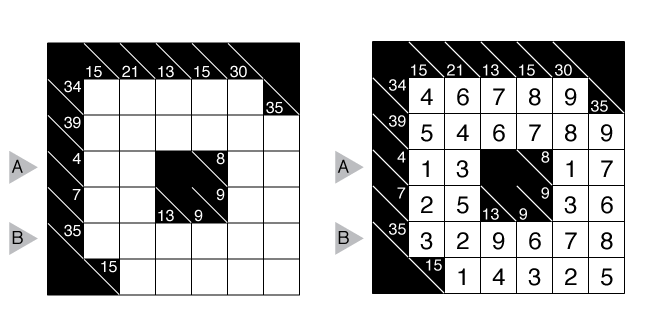Kakuro Rules and Info

Rules: Enter a single digit from 1 to 9 into each white cell so that the sum of digits in each Across entry equals the value given to the left of the entry, and the sum of digits in each Down entry equals the value given above the entry. No digit may be repeated within a single entry (i.e., group of cells connected horizontally or vertically without any black cells between).
Answer String: Enter the values in each white cell in the marked rows from left to right, separating the rows with a comma. Ignore black cells. This example has the key “1317,329678”.
(Brief) History of Kakuro: Descended from arithmetic puzzles and from crosswords. The puzzle was created around 1950 by Canadian Jacob E. Funk under the name “Cross Sums” and gained popularity in Dell puzzle magazines. Like its counterpart “Number Place”, now known as Sudoku, Cross Sums was brought back to Japan and became more famous under its foreign name. Kakuro is an abbreviation of the Japanese phrase Kasan Kurosu (加算クロス, meaning addition cross).
History of this example: This Kakuro was written by Thomas Snyder.
Sources for Kakuro Puzzles: Follow this link for classic Kakuro puzzles on this website and this link for variations on Kakuro puzzles. If you are new to this puzzle type, here are our easiest Kakuro puzzles to get started on. More Kakuro puzzles can be found in Kakuro and Variations by Serkan Yürekli and in The Art of Puzzles 2.
Design rules for contributors: A Grandmaster Kakuro will have a unique solution that can be reached by logic alone. Generally, a Grandmaster Kakuro should have a symmetric layout of black cells or an interesting visual theme in the absence of symmetry. Not all clues need to be given, and single digit entries are rarely present and never clued. Sizes from 9×9 and above are recommended (maximum aspect ratio of 2:1 if rectangular).
